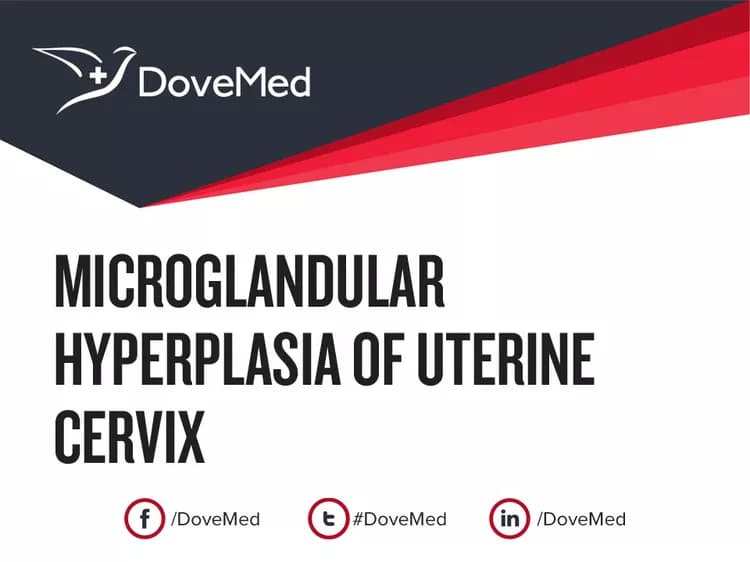What are the other Names for this Condition? (Also known as/Synonyms)
- Cervical Microglandular Hyperplasia
- MGH of Uterine Cervix
- Microglandular Hyperplasia of Cervix
What is Microglandular Hyperplasia of Uterine Cervix? (Definition/Background Information)
- Microglandular Hyperplasia (MGH) of Uterine Cervix is a benign condition that occurs due to an abnormal increase of glands (endocervical glands) within the cervix
- It is mostly diagnosed in young adult women or during pregnancy. Microglandular Hyperplasia of Cervix is believed to form due to hormonal factors
- It is not associated with any significant signs and symptoms or complications, though in some women abnormal vaginal bleeding may be observed. The presence of Microglandular Hyperplasia of Uterine Cervix may be noted as a mass or polyp
- Treatment course includes observation of the mass in asymptomatic cases and surgical management, if necessary. In general, the prognosis of Microglandular Hyperplasia of Uterine Cervix is excellent with suitable treatment
Who gets Microglandular Hyperplasia of Uterine Cervix? (Age and Sex Distribution)
- Microglandular Hyperplasia of Uterine Cervix is observed in adult women, but is most common between ages 20-35 years (during the active reproductive phase of a woman)
- There is no known ethnic or racial preference
What are the Risk Factors for Microglandular Hyperplasia of Uterine Cervix? (Predisposing Factors)
No definitive risk factors have been identified for Microglandular Hyperplasia of Uterine Cervix. However, the following may be noted:
- Many cases have been associated with pregnancy
- MGH is associated with progestins: Progestins are synthetic drugs used to treat menstrual cycle disturbances, or are taken as oral contraceptives
It is important to note that having a risk factor does not mean that one will get the condition. A risk factor increases ones chances of getting a condition compared to an individual without the risk factors. Some risk factors are more important than others.
Also, not having a risk factor does not mean that an individual will not get the condition. It is always important to discuss the effect of risk factors with your healthcare provider.
What are the Causes of Microglandular Hyperplasia of Uterine Cervix? (Etiology)
- Currently, the exact cause and mechanism of formation of Microglandular Hyperplasia of Uterine Cervix is unknown
- The condition may be caused by hormonal imbalance or conditions causing abnormal hormonal stimulation in the body
What are the Signs and Symptoms of Microglandular Hyperplasia of Uterine Cervix?
Generally, no signs and symptoms of Microglandular Hyperplasia of Uterine Cervix are observed and a majority of the women are asymptomatic. In some cases, the following signs and symptoms may be noted:
- Abnormal vaginal bleeding
- The presence of a mass may be noted in some cases, which can easily break or collapse
- MGH is mostly contained within an endocervical polyp
How is Microglandular Hyperplasia of Uterine Cervix Diagnosed?
A diagnosis of Microglandular Hyperplasia of Uterine Cervix may involve the following steps:
- Evaluation of the individual’s medical history and a thorough physical (pelvic) examination
- Transvaginal ultrasound scan
- Colposcopy: The cervix is examined with an instrument, called a colposcope. This helps the physician get a magnified view of the cervix
Cervical biopsy: It is the process of removing tissue for examination. In the case of MGH, a complete excision and removal of the mass can help in the process of a biopsy, as well as be a means for treating the condition.
A pathologist looks at the tissue sample under a microscope, to detect any evidence of cancer. Types of cervical biopsies include:
- Colposcopic biopsy: The abnormal areas of the cervix are visualized with a colposcope. After numbing the cervix with a local anesthetic, an instrument, called a biopsy forceps, is used to get a tissue sample. Mild cramps, pain, and some light bleeding, may occur following the procedure
- Endocervical curettage (endocervical scraping): The curette is an instrument that can be used to scrape out tissue. Using a curette, cells are scraped out from the endocervix (the inner part of the cervix, close to the uterus/womb) and examined under a microscope. Mild pain and bleeding may be present following the procedure
Note: Excessive gland growth showing atypical features under the microscope raises the possibility of a clear cell carcinoma. A careful examination is often necessary to rule out a malignancy in such cases.
Many clinical conditions may have similar signs and symptoms. Your healthcare provider may perform additional tests to rule out other clinical conditions to arrive at a definitive diagnosis.
What are the possible Complications of Microglandular Hyperplasia of Uterine Cervix?
Significant complications from Microglandular Hyperplasia of Cervix are generally not noted, because it is a benign condition.
How is Microglandular Hyperplasia of Uterine Cervix Treated?
The treatment measures for Microglandular Hyperplasia of Uterine Cervix may include the following:
- If there are no symptoms, then the healthcare provider may chose not to treat the condition
- If it forms a mass, then surgical intervention with complete excision is usually considered
- Post-operative care is important: Minimum activity level is to be ensured until the surgical wound heals
- Follow-up care with regular screening and check-ups are important
How can Microglandular Hyperplasia of Uterine Cervix be Prevented?
- Current medical research has not established a method of preventing Microglandular Hyperplasia of Uterine Cervix
- Medical screening at regular intervals with scans and physical examinations are advised
What is the Prognosis of Microglandular Hyperplasia of Uterine Cervix? (Outcomes/Resolutions)
- The prognosis of Microglandular Hyperplasia of Uterine Cervix is excellent with appropriate treatment, since it is a benign condition
- No malignancy is known to be associated with Cervical Microglandular Hyperplasia
Additional and Relevant Useful Information for Microglandular Hyperplasia of Uterine Cervix:
Please visit our Women’s Health center for more physician-approved health information:
Related Articles
Test Your Knowledge
Asked by users
Related Centers
Related Specialties
Related Physicians
Related Procedures
Related Resources
Join DoveHubs
and connect with fellow professionals


0 Comments
Please log in to post a comment.